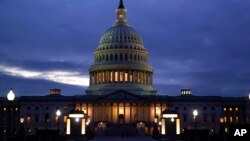U.S. President Joe Biden and congressional leaders are set to meet next week to discuss ways the United States could avoid a looming debt ceiling crisis.
In January, Treasury Secretary Janet Yellen temporarily postponed that crisis through "extraordinary measures," creative accounting that moved debt among government agencies as payments come due, suspending investment in the purchase and selling of currencies, and temporarily pausing investment in pension plans for government workers.
But even with these measures, the U.S. Treasury and most economists estimate the U.S. will hit the debt ceiling in early June.
What is the debt ceiling?
Also called the debt limit, the debt ceiling is a federal law that caps the amount of money the U.S. can borrow to meet legal spending obligations.
Every year since 2001, the U.S. government has spent more than the revenue it brings in through taxes and fees. The government borrows money to cover the funding gap so it can continue to pay for an array of federal programs and agencies, from the U.S. military to Social Security and Medicare. The government raises this money by selling interest-bearing securities such as Treasury bonds.
Contrary to some public perceptions, raising the debt ceiling does not authorize the U.S. to spend more money. Congress has ultimate authority over the budget process, and each year, lawmakers vote on spending bills. But since 1917, there has also been a legal limit imposed on the amount of debt that the U.S. government can take on. Raising the debt limit simply authorizes the Treasury Department to make payments on spending that Congress already approved.
How often has the debt ceiling been raised?
The U.S. has raised the debt ceiling 78 times since 1960, according to the Treasury Department. Congress votes to raise the debt ceiling separately from votes on government spending or taxation.
At some point, the U.S. will have to resolve the impasse by raising the debt ceiling or massively cutting back on its obligations. For most of the lawmakers, Democrat and Republican alike, halting funding for the military or severing Social Security payments would be unthinkable.
What happens if the debt ceiling isn't raised?
Some economists warn that a first-ever failure to pay interest on America's $31.4 trillion national debt would trigger wide-ranging global consequences, including a downgrade of the United States' credit rating and a devaluing of the U.S. dollar that could possibly lead to a stock market crash and an economic recession.
How do Republicans propose resolving the crisis?
Many Republican lawmakers say the federal government spends too much money. Some suggest refusing to raise the debt limit as a way to rein in expenditures.
Last month, House Republicans narrowly passed legislation that would raise the debt ceiling by $1.5 trillion in exchange for cuts to government spending and an end to clean energy cuts passed last year. The legislation has no chance of passing the Democratic-controlled Senate.
Mark Zandi, chief economist at Moody's Analytics, warned a Senate budget panel Thursday that the legislation would "reduce employment by the end of 2024 by about 800,000 jobs, and add meaningfully to unemployment by almost a half a percentage point."
Senate Minority Leader Mitch McConnell said this week that Republicans would not agree to lift the ceiling without spending cuts.
"In seven of the last 10 negotiations on the debt limit, there have been budgetary reforms," McConnell told reporters Tuesday. "And that's supported by the American people, polls show that 65% of the American people believe that you shouldn't raise the debt limit without doing something about the debt."
How do the White House and congressional Democrats propose to resolve the standoff with Republicans?
Biden and Democrats, who hold a slim majority in the Senate, want to raise the debt ceiling as has often been done with little or no debate in past decades. Senate Majority Leader Chuck Schumer told reporters Tuesday that Democrats support a clean debt ceiling bill that raises the limit until December 31, 2024.
"Congress needs to take action to prevent default without hostage taking or political brinksmanship, just as they did three times under the last president," Shalanda Young, director of the Office of Management and Budget, told reporters on Thursday.
"But I want to be really clear: This is not some abstract debate," she said. "This is about real people's lives."
What happens next?
A compromise between the two parties is necessary because any legislation passed in the Republican-majority House of Representatives also must pass the Democratic-majority Senate and be signed into law by Biden.
In 2011, as the U.S. approached a debt ceiling breach, the Republican-majority House asked then-President Barack Obama for a series of spending cuts in return for raising the borrowing limit. Two days before the Department of Treasury estimated the limit would be exhausted, Republicans agreed to the raise in return for a package of future cuts.
Despite averting fiscal catastrophe, America's long-term credit rating was downgraded slightly in 2011, due in part to the debt ceiling brinksmanship in Washington. Economists fear the current standoff could trigger another downgrade.
The U.S. raised the debt ceiling three times while Republican President Donald Trump was in office. Republicans controlled the Senate for the entirety of his administration and the House for his first two years in office.








